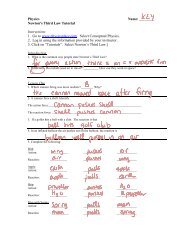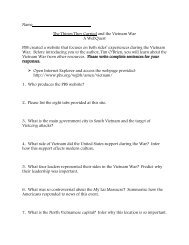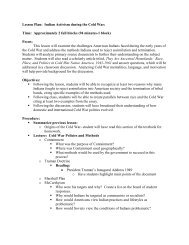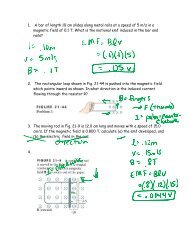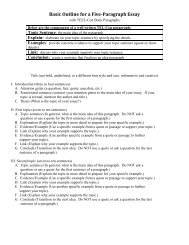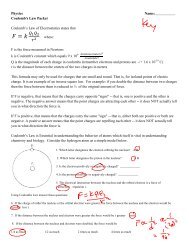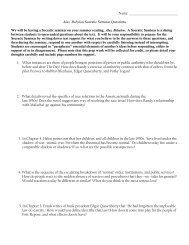Seely 1 Lesson Plan: The Red Summer: An Examination of Urban ...
Seely 1 Lesson Plan: The Red Summer: An Examination of Urban ...
Seely 1 Lesson Plan: The Red Summer: An Examination of Urban ...
You also want an ePaper? Increase the reach of your titles
YUMPU automatically turns print PDFs into web optimized ePapers that Google loves.
<strong>Seely</strong> 1<br />
<strong>Lesson</strong> <strong>Plan</strong>:<br />
<strong>The</strong> <strong>Red</strong> <strong>Summer</strong>: <strong>An</strong> <strong>Examination</strong> <strong>of</strong> <strong>Urban</strong> Violence and Race Relations in Chicago<br />
Focus:<br />
This lesson will primarily focus on the relationship between the<br />
concentration <strong>of</strong> African Americans in an urban area, such as Chicago, and the<br />
increased violence between blacks and whites. <strong>An</strong> analysis <strong>of</strong> the Chicago Race<br />
Riots <strong>of</strong> 1919 will serve as an in-depth case study. Students will focus their research<br />
on the social, economic, and political conditions <strong>of</strong> Chicago and attempt to explain<br />
how these conditions led to the <strong>Red</strong> <strong>Summer</strong>. Students will be examining primary<br />
sources derived from various newspapers and photographers, detailing the<br />
accounts before and after the riots. Students will discuss these observations in<br />
class.<br />
Objectives:<br />
• Following the lesson, students will be able to recognize at least five reasons<br />
why tension existed between blacks and whites in Chicago.<br />
• Following class, students will be able to create their own argument why<br />
violence in urban areas, such as Chicago, became more prominent and more<br />
violent.<br />
• Following the discussion, students will understand both sides to the racial<br />
tension that existed within Chicago.<br />
• Following the activity, students will be able to link commonalities between<br />
the Chicago Race Riot <strong>of</strong> 1919 and the movement towards civil rights.<br />
Procedure:<br />
• Begin class by summarizing the previous lesson. Students will answer a<br />
general question concerning whether the concentration <strong>of</strong> a particular group<br />
<strong>of</strong> people makes any ethnic or racial group an easy target for violence? (5-<br />
10)<br />
• Following any questions by students, the students will be introduced to the<br />
story <strong>of</strong> Eugene Williams and the start <strong>of</strong> the Chicago Race Riot using an<br />
excerpt from William M. Tuttle’s Race Riot: Chicago in the <strong>Red</strong> <strong>Summer</strong>.<br />
Students will discuss their initial feelings and attitudes toward the event.<br />
(10)<br />
• Students will then divide up into groups <strong>of</strong> 4 to read Walter White’s Chicago<br />
and its Eight Reasons. Each group will have the responsibility to explore one<br />
<strong>of</strong> the eight issues and discuss its relevance to the topic. Students will also be<br />
examining documents and pictures that correspond to the topic. (35-40)<br />
• Have students circle their desks around the room, preparing for discussion.<br />
We will discuss several questions and ultimately draw our own conclusions<br />
on the relationship between racial concentration in urban environments and<br />
the correlation to violence toward them. (30)<br />
• To conclude the lesson, students will determine which factor had the most<br />
influence on the violence that occurred in 1919. This will be assigned as a<br />
written homework assignment.
<strong>Seely</strong> 2<br />
Assessment:<br />
• Students will be assessed in several different ways. Students will first be<br />
assessed on their homework. Students will also be assessed on their<br />
participation in the class discussion and their ability to create new question<br />
or add to the class discussion in a positive way. Students will be assessed<br />
also at the end <strong>of</strong> class to see if they understand how major topics <strong>of</strong><br />
American history are connected together. In addition, students will be<br />
assessed on their ability to retain information through their unit exam and a<br />
chapter quiz.<br />
Sources, Materials, and Accommodations:<br />
• “Chicago and Its Eight Reasons”: Walter White Considers the Causes <strong>of</strong> the<br />
1919 Chicago Race Riot<br />
• Maps/Charts discussing African American populations, locations, etc…<br />
• Primary Sources (Chicago Defender, Chicago Daily Tribune, Photographs)<br />
<strong>Plan</strong> “B” Option:<br />
• If class time is running out, I will assign the summary as homework and<br />
discuss the issue during the next available class.<br />
• If class time is excess, I will have students write their reasoning in class and<br />
will be further discussed if time permits.
<strong>Seely</strong> 3
<strong>Seely</strong> 4
<strong>Seely</strong> 5
<strong>Seely</strong> 6
<strong>Seely</strong> 7
<strong>Seely</strong> 8
<strong>Seely</strong> 9
<strong>Seely</strong> 10
<strong>Seely</strong> 11<br />
<strong>The</strong> Chicago Race Riot <strong>of</strong> 1919<br />
After World War I ended in November 1918, thousands <strong>of</strong> American<br />
servicemen, black and white, returned home from Europe and looked<br />
for jobs, as many <strong>of</strong> them had held prior to the war, in the factories,<br />
mills, and warehouses <strong>of</strong> the nation's major industrial cities. White<br />
soldiers <strong>of</strong>ten sought to reclaim jobs they had held before going to war.<br />
Black soldiers, by contrast, expected their status as war veterans to<br />
qualify them for jobs they had previously been denied on the basis <strong>of</strong><br />
race. As the postwar economy contracted, however, the total number <strong>of</strong><br />
job openings declined. In many cities, whites and blacks found<br />
themselves, unhappily, competing for the same jobs. Racial tensions<br />
steadily escalated until, in the summer <strong>of</strong> 1919, race riots erupted in no<br />
less than twenty American cities. <strong>The</strong> largest and most violent <strong>of</strong> these<br />
riots occurred in Chicago.<br />
<strong>The</strong> riot began on July 27, after an African-American youth named<br />
Eugene Williams, while swimming with friends in Lake Michigan near<br />
29th Street, strayed into an area informally reserved for the exclusive<br />
use <strong>of</strong> white bathers. For this, Williams was pelted with stones by an<br />
unruly group <strong>of</strong> young white men and soon drowned. When the police<br />
ignored eyewitness accounts <strong>of</strong> the event and refused to arrest those<br />
responsible for the boy's death, indignant crowds <strong>of</strong> blacks gathered in<br />
protest. Distorted accounts <strong>of</strong> the incident inflamed already tense<br />
relations between black and white Chicagoans. For the next two weeks,<br />
gangs <strong>of</strong> unruly whites and mobs <strong>of</strong> outraged blacks clashed with one<br />
another in sporadic fighting across the city's South Side. On the fourth<br />
day <strong>of</strong> rioting, the state militia was deployed to restore order, but the<br />
fighting continued. In the end, the violence claimed the lives <strong>of</strong> 38<br />
Chicagoans: 23 blacks, 15 whites. Additionally, over 500 were injured.<br />
<strong>An</strong>d hundreds <strong>of</strong> families lost everything when their homes were<br />
torched by rioters.<br />
In the wake <strong>of</strong> some <strong>of</strong> the worst rioting in the city's history, Chicagoans<br />
looked for ways to prevent similar episodes in the future. Some <strong>of</strong>fered<br />
quick fixes, including some that would have legitimated racial<br />
discrimination in matters <strong>of</strong> hiring and housing. One proposal called for<br />
banning African-Americans from working alongside whites in the<br />
stockyards; another suggested that zoning laws be used to formally<br />
segregate black and white residential areas. Such proposals, though<br />
given much attention in newspapers catering to the city's majority white<br />
population, were rejected by Chicago's African-American and liberal<br />
white residents.<br />
Instead, city leaders and concerned citizens took the occasion to
<strong>Seely</strong> 12<br />
examine more closely the state <strong>of</strong> relations between white and black<br />
Chicagoans. <strong>The</strong>y formed a special commission--the Chicago<br />
Commission on Race Relations--to investigate the sociological origins <strong>of</strong><br />
the riot and suggest ways to improve race relations in the city. This<br />
commission concluded that a variety <strong>of</strong> factors--competition for jobs,<br />
inadequate housing options for blacks, inconsistent enforcement <strong>of</strong> the<br />
law, and other forms <strong>of</strong> direct and indirect racial discrimination--had<br />
soured relations between white and black Chicagoans and created an<br />
environment conducive to race riots. While improvements in these<br />
areas would be slow and difficult to attain, the commission's<br />
recommendations at least envisioned a future in which racial equality,<br />
not racial segregation, would be the standard for all municipal policies.<br />
1919 Race Riot Documents<br />
Seeking the Cause<br />
Source: Chicago Defender, editorial, 9 August<br />
1919, pg. 16.<br />
SO MANY THEORIES HAVE BEEN ADVANCED as to the probable<br />
cause <strong>of</strong> the outbreaks between the races in the different northern cities that<br />
it is difficult for the man or woman whose opinion is based on the stories<br />
presented in the daily press to select any one that will hold longer than a day,<br />
or until the next edition <strong>of</strong> the paper appears. Those who try to make these<br />
outbursts <strong>of</strong> the lawless acute, those who believe, for instance, that the<br />
regrettable affair at the bathing beach here in Chicago was sufficient to set in<br />
motion this machine <strong>of</strong> destruction, are far from the right track.<br />
DOES ANY LOGICAL thinking man or woman believe that the recent<br />
world war could have been staged on an incident as trivial-- speaking, in the<br />
larger sense-- as the killing <strong>of</strong> one, two or a dozen relatives <strong>of</strong> a royal<br />
family? Is it not conceded that for years Germany, France, England, Russia<br />
and Japan had axes to grind, that they cherished little love for each other,<br />
that territorial aggrandizement, trade monopoly and other vital questions<br />
were gnawing at their very heart strings? Was it not clearly proven that<br />
Germany contemplated and prepared for war for forty years. Had a friendly<br />
feeling existed would not the killing <strong>of</strong> these members <strong>of</strong> the royal family<br />
been amicably adjusted without further bloodshed?<br />
SINCE THE BLACK MAN became an economic factor in the life <strong>of</strong> the<br />
North two things happened. <strong>The</strong> South awakened to the fact that they were<br />
losing their main prop, and financial destruction stared them in the face if<br />
means were not immediately devised to check the vast hordes <strong>of</strong> labor that<br />
were leaving that section. <strong>The</strong> southerner may be a little behind the times,
<strong>Seely</strong> 13<br />
but he has learned the art <strong>of</strong> squealing as loud as anybody when his<br />
pocketbook is meddled with. First his free slave labor was wrested from him;<br />
now the North is gobbling up his cheap labor. While he cried with one breath<br />
for deliverance from the Black man, with the next came all sorts <strong>of</strong> pleadings<br />
and dire threats to the one who enticed the Black man from the land <strong>of</strong> cane<br />
and cotton. Enigma? Yes, but what's to be done about it?<br />
THE NORTHERNER, too, had an awakening when, through necessity he<br />
placed the Black man in his shops, factories and industrial plants, he found<br />
not the shiftless, lazy tout that had been pictured, but a bright, energetic, apt,<br />
useful and reliable workman, so a permanent place was found for him and he<br />
was asked to have his brothers come and partake <strong>of</strong> his good fortune.<br />
THERE IS ALWAYS FRICTION when two bodies try to occupy the same<br />
place at the same time. <strong>The</strong> close <strong>of</strong> the war threw thousands out <strong>of</strong><br />
employment. <strong>The</strong> American white man, believing himself justly entitled to<br />
first pick, questioned the right <strong>of</strong> a Black man to be holding a job he could<br />
fill. <strong>The</strong> Black man, dating his final papers entitling him to a place in the sun<br />
from the day he landed from overseas, where he had been <strong>of</strong>fering his life for<br />
the honor <strong>of</strong> his country, pointed to his record as an American citizen and<br />
refused longer to be the tool <strong>of</strong> any man. This display <strong>of</strong> manhood brought<br />
his enemies to their feet and by fair means or foul it was seemingly agreed to<br />
poison the minds <strong>of</strong> our friends. <strong>The</strong> methods employed have been both<br />
cunning and dastardly. <strong>The</strong> bourbon press throughout the country have aided<br />
and abetted this insidious propaganda and have constantly played their trump<br />
card, "A big, burly black brute attacks a white woman."<br />
IT IS AS IMPOSSIBLE to segregate a group <strong>of</strong> people who comprise such a<br />
large percentage <strong>of</strong> the whole population as it is to fly to the moon. <strong>An</strong>d<br />
every instance where segregation has been practiced we find a retarded<br />
growth and the mob supreme, while the price <strong>of</strong> a human life is at the zero<br />
mark.<br />
Torch Rioters Give Firemen Continuous Job<br />
Alarms by Score During the Night; Stones Fly.<br />
Source: Chicago Daily Tribune, 31 July 1919, pg. 2.<br />
More than forty fires touched <strong>of</strong>f by rioters in the black belt last night kept engine and truck<br />
companies clanging up and down the streets almost continuously from 8:30 until 10 o'clock.<br />
It was not until the troops moved into the district that the firemen were able to catch their<br />
breath. <strong>The</strong> calls came so fast the fire alarm operators could hardly keep track <strong>of</strong> them and<br />
engine company No. 50, at Forty-seventh street and Wentworth avenue, was kept so busy<br />
that two companies-- engine company No. 19 and truck company 15-- were sent to its aid.<br />
Fifty-two alarms had been turned in by 10:30, more than forty <strong>of</strong> which were said to be in
<strong>Seely</strong> 14<br />
the district bounded by Wells street and Wentworth Avenue and Thirty-ninth and Fifty-third<br />
streets. During the day sixty-five alarms had been sounded.<br />
Mob at Burning Building.<br />
When firemen reached a burning two story brick building at 5029 Shields avenue they found<br />
a howling mob outside and two old Negro men, two colored women, and a white girl<br />
cowering under a large table on the second floor. <strong>The</strong> occupants were rescued and the fire<br />
extinguished. Negroes set fire to the home <strong>of</strong> a Mrs. Donohue, at 746 West Fifty-Second<br />
Street, and shots were being fired into the windows when the fire companies reached the<br />
scene.<br />
At 4757 South Wells street, occupied by Negroes, a crowd dragged a talking machine and<br />
other articles <strong>of</strong> furniture outside and set fire to them. Firemen extinguished a blaze at 5422<br />
South La Salle street at 10 o'clock, only to be called back to put out a second one at 11:30.<br />
Barns and wood sheds in the rear <strong>of</strong> houses occupied by Negroes were set on fire at 215,<br />
245, and 248 West Forty-Sixth Street. Several homes vacated by Negroes during the day<br />
were found in flames.<br />
Other Fires.<br />
Other addresses at which fires broke out were:<br />
5031 Shields avenue.<br />
4802 Wentworth avenue.<br />
4447 Wentworth avenue.<br />
4746 South Wells street.<br />
4742 South Wells street.<br />
148 West Forty-fourth street.<br />
3910 South Wells street.<br />
4744 South Wells street.<br />
4535 Portland avenue.<br />
4716 South Wells street.<br />
4735 South Wells street.<br />
6817 Elizabeth street.<br />
3735 South Wells street.<br />
4617 South Wells street.<br />
2932 South Wells street.<br />
Firemen Stoned.<br />
Several false alarms were turned in by rioters, evidently with the intention <strong>of</strong> stoning the<br />
firemen when they arrived on the scene. This occurred on several occasions. Marshal Joseph<br />
Kenyon <strong>of</strong> the 12th battalion was responding to an alarm at Fifty-fourth and Dearborn<br />
streets with engine company No. 51 when he was turned back by the police and warned<br />
there was no fire there.<br />
A crowd <strong>of</strong> Negroes stopped in front <strong>of</strong> the headquarters <strong>of</strong> engine company 61 at 5300<br />
Wentworth avenue and attacked twenty white men. Firemen closed the doors to the station,<br />
whereupon the Negroes began firing through the doors. Several men climbed through the<br />
windows to escape the crowd outside.
<strong>Seely</strong> 15<br />
Whites fired the house at 5432 La Salle street, into which a colored family had just moved.<br />
<strong>The</strong> family fled to safety.<br />
Shot at His Window.<br />
Charles Cromier was sitting in his window at 2839 Cottage Grove avenue watching the<br />
clashing mobs. A stray bullet lodged in his head and he fell back into the room. Spectators<br />
saw him being helped to a chair by a woman.<br />
Racial feeling, which had been on par with the weather during the day took fire shortly after<br />
5 o'clock when white bathers at the Twenty-ninth street improvised beach saw a colored boy<br />
on a raft paddling into what they termed "white" territory.<br />
A snarl <strong>of</strong> protest went up from the whites and soon a volley <strong>of</strong> rocks and stones were sent<br />
in his direction. One rock, said to have been thrown by George Stauber <strong>of</strong> 2904 Cottage<br />
Grove avenue, struck the lad and he toppled into the water.<br />
Cop Refuses to Interfere.<br />
Colored men who were present attempted to go to his rescue, but they were kept back by<br />
the whites, it is said. Colored men and women, it is alleged, asked Policeman Dan Callahan<br />
<strong>of</strong> the Cottage Grove station to arrest Stauber, but he is said to have refused.<br />
<strong>The</strong>n, indignant at the conduct <strong>of</strong> the policeman, the Negroes set upon Stauber and<br />
commenced to pommel him. <strong>The</strong> whites came to his rescue and then the battle royal was on.<br />
Fists flew and rocks were hurled. Bathers from the colored Twenty-fifth street beach were<br />
attracted to the scene <strong>of</strong> the battling and aided their comrades in driving the whites into the<br />
water.<br />
Negroes Chase Policeman.<br />
<strong>The</strong>n they turned on Policeman Callahan and drove him down Twenty-ninth street. He ran<br />
into a drug store at Twenty-ninth street and Cottage Grove avenue and phoned the Cottage<br />
Grove avenue station.<br />
Two wagon loads <strong>of</strong> cops rolled to the scene, and in a scuffle that ensued here Policeman<br />
John O'Brien and three blacks were shot.<br />
Riot calls were sent to the Cottage Grove avenue station and more reserves were sent into<br />
the black belt. By this time the battling had spread along Cottage Grove avenue and<br />
outbreaks were conspicuous at nearly every corner.<br />
Meanwhile the fighting continued along the lake. Miss Mame McDonald and her sister,<br />
Frances, had been bathing with a friend, Lieut. Runkle, a convalescing soldier. A colored<br />
woman walked up to the trio and made insulting remarks, it is said.<br />
Runkle attempted to interfere, but the colored woman voiced a series <strong>of</strong> oaths and promptly<br />
struck the soldier in the face. Negroes in the vicinity hurled stones and rocks at the women<br />
and both were slightly injured.<br />
Reserves Called Out.<br />
In less than a half hour after the beach outbreak, Cottage Grove avenue and State street
<strong>Seely</strong> 16<br />
from Twenty-ninth south to Thirty-fifth were bubbling cauldrons <strong>of</strong> action.<br />
When the situation had gotten beyond the control <strong>of</strong> the Cottage Grove police, Acting Chief<br />
<strong>of</strong> Police Alcock was notified. He immediately sent out a call to every station in the city to<br />
rush all available men to the black belt. Before they arrived colored and white men were<br />
mobbed in turn. <strong>The</strong> blacks added to the racial feeling by carrying guns and brandishing<br />
knives. It was not until the reserves arrived that the rioting was quelled.<br />
Whites Arm Selves.<br />
News <strong>of</strong> the afternoon doings had spread through all parts <strong>of</strong> the south side by nightfall, and<br />
whites stood at all prominent corners ready to avenge the beatings their brethren had<br />
received. Along Halsted and State streets they were armed with clubs, and every Negro who<br />
appeared was pommeled.<br />
Lewis Phillips, colored, was riding in a Thirty-ninth street car, when a white man took a pot<br />
shot from the corner as the car neared Halsted street. Phillips was wounded in the groin and<br />
was taken to the Provident hospital.<br />
Melvin Davies, colored, <strong>of</strong> 2816 Cottage Grove avenue, was waiting for a Thirty-fifth street<br />
car at Parnell avenue when he was slugged from behind. His assailants disappeared.
<strong>Seely</strong> 17<br />
<strong>An</strong> armed solider and Chicago police <strong>of</strong>ficers patrolling the streets <strong>of</strong> Chicago (July, 1919)
<strong>Seely</strong> 18<br />
Results <strong>of</strong> the Race Riot: Vandalized African-American home (July 29,1919)<br />
Brick-wielding Whites in Pursuit <strong>of</strong> a Black Victim, 1919
<strong>Seely</strong> 19<br />
CHICAGO AND ITS EIGHT REASONS (Chicago: October 1919)<br />
Walter F. White<br />
MANY causes have been assigned for the three days <strong>of</strong> race rioting, from July 27 to 30 in<br />
Chicago, each touching some particular phase <strong>of</strong> the general condition that led up to the<br />
outbreak. Labor union <strong>of</strong>ficials attribute it to the action <strong>of</strong> the packers, while the packers<br />
are equally sure that the unions themselves are directly responsible. <strong>The</strong> city<br />
administration feels that the riots were brought on to discredit the Thompson forces,<br />
while leaders <strong>of</strong> the anti-Thompson forces, prominent among them being State's Attorney<br />
Maclay Hoyne, are sure that the administration is directly responsible. In this manner<br />
charges and counter-charges are made, but, as is usually the case, the Negro is made to<br />
bear the brunt <strong>of</strong> it all—to be “the scapegoat.” A background <strong>of</strong> strained race relations<br />
brought to a head more rapidly through political corruption, economic competition and<br />
clashes due to the overflow <strong>of</strong> the greatly increased colored population into sections<br />
outside <strong>of</strong> the so-called “Black Belt,” embracing the Second and Third Wards, all <strong>of</strong> these<br />
contributed, aided by magnifying <strong>of</strong> Negro crime by newspapers, to the formation <strong>of</strong> a<br />
situation where only a spark was needed to ignite the flames <strong>of</strong> racial antagonism. That<br />
spark was contributed by a white youth when he knocked a colored lad <strong>of</strong>f a raft at the<br />
29th Street bathing beach and the colored boy was drowned.<br />
Four weeks spent in studying the situation in Chicago, immediately following the<br />
outbreaks, seem to show at least eight general causes for the riots, and the same<br />
conditions, to a greater or less degree, can be found in almost every large city with an<br />
appreciable Negro population. <strong>The</strong>se causes, taken after a careful study in order <strong>of</strong><br />
their prominence, are:<br />
1. Race Prejudice. 2. Economic Competition. 3. Political Corruption and<br />
Exploitation <strong>of</strong> Negro Voters. 4. Police Inefficiency. 5. Newspaper Lies about Negro<br />
Crime. 6. Unpunished Crimes Against Negroes. 7. Housing. 8. Reaction <strong>of</strong> Whites<br />
and Negroes from War.<br />
Some <strong>of</strong> these can be grouped under the same headings, but due to the prominence <strong>of</strong><br />
each they are listed as separate causes.<br />
Prior to 1915, Chicago had been famous for its remarkably fair attitude toward colored<br />
citizens. Since that time, when the migratory movement from the South assumed large<br />
proportions, the situation has steadily grown more and more tense. This was due in part<br />
to the introduction <strong>of</strong> many Negroes who were unfamiliar with city image ways and could<br />
not, naturally, adapt themselves immediately to their new environment. Outside <strong>of</strong> a few<br />
sporadic attempts, little was done to teach them the rudimentary principles <strong>of</strong> sanitation, <strong>of</strong><br />
conduct or <strong>of</strong> their new status as citizens under a system different from that in the South.<br />
During their period <strong>of</strong> absorption into the new life, their care-free, at times irresponsible and<br />
sometimes even boisterous, conduct caused complications difficult to adjust. But equally<br />
important, though seldom considered, is the fact that many Southern whites have also come<br />
into the North, many <strong>of</strong> them to Chicago, drawn by the same economic advantages that<br />
attracted the colored workman. <strong>The</strong> exact figure is unknown, but it is estimated by men who
<strong>Seely</strong> 20<br />
should know that fully 20,000 <strong>of</strong> them are in Chicago. <strong>The</strong>se have spread the virus race<br />
hatred and evidences <strong>of</strong> it can be seen in Chicago on every hand. This same cause underlies<br />
each <strong>of</strong> the other seven causes.<br />
With regard to economic competition, the age-long dispute between capital and labor<br />
enters. Large numbers <strong>of</strong> Negroes were brought from the South by the packers and there<br />
is little doubt that this was done in part so that the Negro might be used as a club over the<br />
heads <strong>of</strong> the unions. John Fitzpatrick and Ed Nockels, president and secretary,<br />
respectively, <strong>of</strong> the Chicago Federation <strong>of</strong> Labor, and William Buck, editor <strong>of</strong> the New<br />
Majority, a labor organ, openly charge that the packers subsidized colored ministers,<br />
politicians and Y. M. C. A. secretaries to prevent the colored workmen at the stockyards<br />
from entering the unions. On the other hand, the Negro workman is not at all sure as to<br />
the sincerity <strong>of</strong> the unions themselves. <strong>The</strong> Negro in Chicago yet remembers the waiters'<br />
strike some years ago, when colored union workers walked out at the command <strong>of</strong> the<br />
unions and when the strike was settled, the unions did not insist that Negro waiters be<br />
given their jobs back along with whites, and, as a result, colored men have never been<br />
able to get back into some <strong>of</strong> the hotels even to the present day. <strong>The</strong> Negro is between<br />
“the devil and the deep blue sea.” He feels that if he goes into the unions, he will lose the<br />
friendship <strong>of</strong> the employers. He knows that if he does not, he is going to be met with the<br />
bitter antagonism <strong>of</strong> the unions. With the exception <strong>of</strong> statements made by organizers,<br />
who cannot be held to accountability because <strong>of</strong> their minor <strong>of</strong>ficial connection, no<br />
statements have been made by the local union leaders, outside <strong>of</strong> high sounding, but<br />
meaningless, protestations <strong>of</strong> friendship for the Negro worker. He feels that he has been<br />
given promises too long already. In fact, he is “fed up” on them. What he wants are<br />
binding statements and guarantees that cannot be broken at will.<br />
With the possible exception <strong>of</strong> Philadelphia, there is probably no city in America with<br />
more <strong>of</strong> political trickery, chicanery and exploitation than Chicago. Against the united<br />
and bitter opposition <strong>of</strong> every daily newspaper in Chicago, William Hale Thompson was<br />
elected again as mayor, due, as was claimed, to the Negro and German vote. While it is<br />
not possible to state that the anti-Thompson element deliberately brought on the riots, yet<br />
it is safe to say that they were not averse to its coming. <strong>The</strong> possibility <strong>of</strong> such a clash<br />
was seen many months before it actually occurred, yet no steps were taken to prevent it.<br />
<strong>The</strong> purpose <strong>of</strong> this was to secure a two-fold result. First, it would alienate the Negro set<br />
from Thompson through a belief that was expected to grow among the colored vote when<br />
it was seen that the police force under the direction <strong>of</strong> the mayor was unable or unwilling<br />
to protect the colored people from assault by mobs. Secondly, it would discourage the<br />
Negroes from registering and voting and thus eliminate the powerful Negro vote in<br />
Chicago. Whether or not this results remains to be seen. In talking with a prominent<br />
colored citizen <strong>of</strong> Chicago, asking why the Negroes supported Thompson so unitedly, his<br />
very significant reply was:<br />
“<strong>The</strong> Negro in Chicago, as in every other part <strong>of</strong> America, is fighting for the fundamental<br />
rights <strong>of</strong> citizenship. If a candidate for <strong>of</strong>fice is wrong on every other public question<br />
except this, the Negroes are going to vote for that man, for that is their only way <strong>of</strong><br />
securing the things they want and that are denied them.”
<strong>Seely</strong> 21<br />
<strong>The</strong> value <strong>of</strong> the Negro vote to Thompson can be seen in a glance at the recent election<br />
figures. His plurality was 28,000 votes. In the second ward it was 14,000 and in the third,<br />
10 000. <strong>The</strong> second and third wards constitute most <strong>of</strong> what is known as the “Black Belt.”<br />
<strong>The</strong> fourth contributing cause was the woeful inefficiency and criminal negligence <strong>of</strong> the<br />
police authorities <strong>of</strong> Chicago, both prior to and during the riots. Prostitution, gambling<br />
and the illicit sale <strong>of</strong> whisky flourish openly and apparently without any fear whatever <strong>of</strong><br />
police interference. In a most dangerous statement, State's Attorney Maclay Hoyne, on<br />
August 25, declared that the riots were due solely to vice in the second ward. He seemed<br />
either to forget or to ignore the flagrant disregard <strong>of</strong> law and order and even <strong>of</strong> the<br />
common principles <strong>of</strong> decency in city management existing in many other sections <strong>of</strong> the<br />
city.<br />
All <strong>of</strong> this tended to contribute to open disregard for law and almost contempt for it. Due<br />
either to political “pull” or to reciprocal arrangements, many notorious dives run and<br />
policemen are afraid to arrest the proprietors.<br />
During the riots the conduct <strong>of</strong> the police force as a whole was equally open to criticism.<br />
State's Attorney Hoyne openly charged the police with arresting colored rioters and with<br />
an unwillingness to arrest white rioters. Those who were arrested were at once released.<br />
In one case a colored man who was fair enough to appear to be white was arrested for<br />
carrying concealed weapons, together with five white men and a number <strong>of</strong> colored men.<br />
All were taken to a police station; the light colored man and the five whites being put into<br />
one cell and the other colored men in another. In a few minutes the light colored man and<br />
the five whites were released and their ammunition given back to them with the remark,<br />
You'll probably need this before the night is over."<br />
Fifth on the list is the effect <strong>of</strong> newspaper publicity concerning Negro crime. With the<br />
exception <strong>of</strong> the Daily News, all <strong>of</strong> the papers <strong>of</strong> Chicago have played up in prominent<br />
style with glaring, prejudice-breeding headlines every crime or suspected crime<br />
committed by Negroes. Headlines such as “NEGRO BRUTALLY MURDERS<br />
PROMINENT CITIZEN,” “NEGRO ROBS HOUSE” and the like have appeared with<br />
alarming frequency and the news articles beneath such headlines have been <strong>of</strong> the same<br />
sort. During the rioting such headlines as “NEGRO BANDITS TERRORIZE TOWN,”<br />
“RIOTERS BURN 100 HOMES—NEGROES SUSPECTED OF HAVING PLOTTED<br />
BLAZE” appeared. In the latter case a story was told <strong>of</strong> witnesses seeing Negroes in<br />
automobiles applying torches and fleeing. This was the story given to the press by Fire<br />
Attorney John R. McCabe after a casual and hasty survey. Later the <strong>of</strong>fice <strong>of</strong> State Fire<br />
Marshall Gamber proved conclusively that the fires were not caused by Negroes, but<br />
by whites. As can easily be seen such newspaper accounts did not tend to lessen the<br />
bitterness <strong>of</strong> feeling between the conflicting groups. Further, many wild and unfounded<br />
rumors were published in the press—incendiary and inflammatory to the highest degree,<br />
a few <strong>of</strong> them being given below in order to show their nature. Some are:<br />
*Over 1,000 Negroes had been slain and their bodies thrown in “Bubbly Creek” and<br />
the Chicago River.
<strong>Seely</strong> 22<br />
*A Negro had been lynched and hanged from a “Loop” building overlooking<br />
Madison Street.<br />
*A white woman had been attacked and mutilated by a Negro on State Street.<br />
*A Negro woman had been slain, her breasts cut <strong>of</strong>f and her infant had been killed<br />
by having its brains dashed out against a wall.<br />
*A white child had been outraged by a colored man.<br />
*A white child bad been kidnapped by a band <strong>of</strong> colored men and its body later<br />
found, badly mutilated and dismembered.<br />
Immediately following the riots, a white woman was murdered in Evanston, III.<br />
Immediately the crime was laid at the door <strong>of</strong> a colored man with whom the woman had<br />
been intimate a number <strong>of</strong> years. Pitiful stories were told <strong>of</strong> the woman waiting for hours<br />
on street corners for “just one look at her Billiken-like, mulatto lover,” played up under<br />
headlines such as “CONFESSION EXPECTED TODAY FKOM NEGRO SUSPECT,”<br />
“NEGRO SUSPECT RAPIDLY WEAKENING” and the like which clearly led one to<br />
believe that the colored man was guilty. A few days later, in an obscure item on an inside<br />
page, a short account was given <strong>of</strong> the release <strong>of</strong> the colored suspect “because insufficient<br />
evidence to hold him” existed. A long period <strong>of</strong> such publicity had inflamed the minds <strong>of</strong><br />
many people against Negroes who otherwise would have been unprejudiced. Much <strong>of</strong> the<br />
blame for the riots can be laid to such sources.<br />
For a long period prior to the riots, organized gangs <strong>of</strong> white hoodlums had been<br />
perpetrating crimes against Negroes for which no arrests had been made. <strong>The</strong>se gangs in<br />
many instances masqueraded under the name <strong>of</strong> “Athletic and Social Clubs” and later<br />
direct connection was shown between them and incendiary fires started during the riots.<br />
Colored men, women and children had been beaten in the parks, most <strong>of</strong> them in Jackson<br />
and Lincoln Parks. In one case a young colored girl was beaten and thrown into a lagoon.<br />
In other cases Negroes were beaten so severely that they had to be taken to hospitals. All<br />
<strong>of</strong> these cases had caused many colored people to wonder if they could expect any<br />
protection whatever from the authorities. Particularly vicious in their attacks was an<br />
organization known locally as “Regan's Colts.”<br />
Much has been written and said concerning the housing situation in Chicago and its effect<br />
on the racial situation. <strong>The</strong> problem is a simple one. Since 1915 the colored population <strong>of</strong><br />
Chicago has more than doubled, increasing in four years from a little over 50,000 to what<br />
is now estimated to be between 125,000 and 150,000. Most <strong>of</strong> them lived in the area<br />
bounded by the railroad on the west, 30th Street on the north, 40th Street on the south and<br />
Ellis Avenue on cast. Already overcrowded this so called “Black Belt” could not possibly<br />
bold the doubled colored population. One cannot put ten gallons <strong>of</strong> water in a five-gallon<br />
pail. Although many Negroes had been living in “white” neighborhoods, the increased<br />
exodus from the old areas created an hysterical group <strong>of</strong> persons who formed “Property<br />
Owners' Associations” for the purpose <strong>of</strong> keeping intact white neighborhoods. Prominent<br />
among these was the Kenwood-Hyde Park Property Owners' Improvement Association,<br />
as well as the Park Manor Improvement Association. Early in June the writer, while in<br />
Chicago, attended a private meeting <strong>of</strong> the first named at the Kenwood Club House, at<br />
Lake Park Avenue and 47th Street. Various plans were discussed for keeping the Negroes
<strong>Seely</strong> 23<br />
in “their part <strong>of</strong> the town,” such as securing the discharge <strong>of</strong> colored persons from<br />
positions they held when they attempted to move into “white” neighborhoods, purchasing<br />
mortgages <strong>of</strong> Negroes buying homes and ejecting them when mortgage notes fell due and<br />
were unpaid, and many more <strong>of</strong> the same calibre. <strong>The</strong> language <strong>of</strong> many speakers was<br />
vicious and strongly prejudicial and had the distinct effect <strong>of</strong> creating race bitterness.<br />
In a number <strong>of</strong> cases during the period from January, 1918, to August, 1919, there were<br />
bombings <strong>of</strong> colored homes and houses occupied by Negroes outside <strong>of</strong> the “Black<br />
Belt.” During this period no less than twenty bombings took place, yet<br />
only two persons have been arrested and neither <strong>of</strong> the two has been<br />
convicted, both cases being continued.<br />
Finally, the new spirit aroused in Negroes by their war experiences<br />
enters into the problem. From Local Board No. 4, embracing the<br />
neighborhood in the vicinity <strong>of</strong> State and 35th Streets, containing over<br />
30,000 inhabitants <strong>of</strong> which fully ninety per cent are colored, over<br />
9,000 men registered and l,850 went to camp. <strong>The</strong>se men, with their<br />
new outlook on life injected the same spirit <strong>of</strong> independence into their<br />
companions, a thing that is true <strong>of</strong> many other sections <strong>of</strong> America.<br />
One <strong>of</strong> the greatest surprises to many <strong>of</strong> those who came down to<br />
“clean out the niggers” is that these same “niggers” fought hack.<br />
Colored men saw their own kind being killed, heard <strong>of</strong> many more and<br />
believed that their lives and liberty were at stake. In such a spirit most<br />
<strong>of</strong> the fighting was done.<br />
THE “INFURIATED” WHITE MOB IN CHICAGO
<strong>Seely</strong> 24<br />
Questions for discussion:<br />
1. Do you think that there is a strong correlation between urban violence and a<br />
concentration <strong>of</strong> a particular ethnic group?<br />
2. What are you initial thoughts and feelings on the case <strong>of</strong> Eugene Williams?<br />
3. Do you feel that one particular party is responsible for the events that<br />
occurred on July 27 th , 1919? Why or why not?<br />
4. What examples can you come up with that illustrate bias in the newspaper<br />
accounts?<br />
5. What do you feel is the most important reason for the violent acts during the<br />
<strong>Red</strong> <strong>Summer</strong>?<br />
6. If you were a city <strong>of</strong>ficial at this time, what would you have done to eliminate<br />
the tension and violence between African Americans and whites?<br />
7. After evaluating the evidence, are minorities more likely to be victims and/or<br />
engaged in violent acts when centralized in urban areas?



